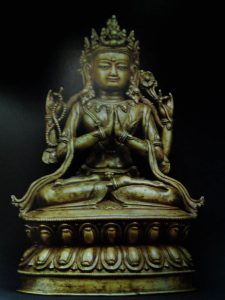Grace Ko

In October 2016, ancient Buddhist statues were a major presence at the season’s art fairs and auctions in Hong Kong, Beijing, and New York. There was an impressive range. Audiences could view Buddhist art from the Eastern Wei Dynasty to the Qing Dynasty, originally from Tibet, Mongolia to Nepal and Central Asia, were showcased in Fine Art Asia and Poly Autumn Auction in Hong Kong, Guardian Fine Art Asia in Beijing, and TEFAF in New York.
Buddhist art has survived for centuries and fallen into the hands of different collectors, proving how its ideas have etched themselves into time across Asia while remaining significant in people’s lives. However, it seems audiences still can’t view this kind of Buddhist art widely at museums or public exhibitions organized by the government or even non-profit making organizations. Still, they are finding their value at art fairs and auction houses, and these are the places for art trading and selling. Viewers can appreciate delicate and exquisite Buddhist art there, while being astonished by its high-selling prices as well.
On 4 October, a gilt bronze figure of Vajrasattva, from 13th century Nepal, was sold for around HK$21 million at Poly Autumn Auction Hong Kong, the highest selling piece of the Buddhist art collection at Poly Auction House that day. Also, a gilt bronze figure of the Dipankara Buddha, from the Kangxi Period (1662–1722), went under the hammer for HK$5.6 million. Another piece, a gilt bronze figure of Bhaisajyaguru from the mid-Ming Dynasty (15th to 16th century), was auctioned for HK$3.3 million.
10 out of 38 pieces of Buddhist art pieces were sold for a wide price range—between
half a million to HK$21 million at Poly Autumn Auction Hong Kong. Those figures are more than just market indicators. They mean that Buddhist statues are prized by collectors, especially Mainland Chinese. The reasons might be aesthetic and cultural and go beyond the idea that investment value is less about the philosophy of Buddhism than the statues’ gold and gilt bronze. The genuine worth goes beyond the materials or form.
Humans cannot hold on to anything, including money, fame, or our bodies. At best, our bodies last us for a few decades. Millennia’s worth of ancient Buddhist art is still being showcased to people in 2016, and its enduring value really impresses me. It makes me feel assured that Buddhist statues will be carefully preserved in the hands of collectors for posterity, partly because of assessments at auctions. They have travelled through time, passing through the hands of collectors, and hopefully awakening spirituality in human beings. In front of these statues, we can see how impermanent we are, not only because of the nature of the prices, but also because of our own physical persons.
